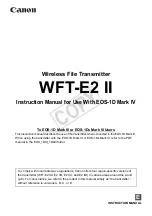
EXC-GT – FM super-compact transmitter series
User’s manual – Page 22 of 98
5)
The input impedance is easily set using the
JP1
e
JP2
jumpers found on the input card, immediately after the input
connectors as illustrated in the design. The selectable impedance values are serigraphed on the printed circuit board.
6)
Place the top cover back on the transmitter, ensuring that all the screws are correctly screwed into place.
,
Do not forget to properly screw all the screws on the top cover into place; this is required to guarantee conformity to
EMI/EMC regulations.
7.8 Preemphasis
The low frequency audio signals of mono and stereo channels must be properly “preemphasized”. The standard preemphasis is 50
or 75 µs, the first value usually being the one selected during manufacture. Confirm that this value is appropriate in your country: it is
the standard value for all countries in Europe, most of the Pacific regions, and some countries in South America. However, the North
American FCC standards require 75 µs.
To make changes to the preemphasis, use the
SETUP
menu as indicated in section 10.3.f.
7.9
Operating with the RDS and SCA encoders
In addition to the aforementioned operating modes, this device is able to transmit an auxiliary signal (RDS or SCA) connected to the
rear
AUX
terminal as follows:
1) Connect
the
AUX
terminal [16] to the RDS or SCA encoder output.
2)
If the internal stereo encoder is used, connect the
MODULATION MONITOR
output [15] to the “driver tone” synchronization
input on the RDS encoder (where available).
3) Using
the
SETUP
-
AUX SENS
menu (
2
section 10.3.d), change the channel input sensitivity and, where necessary, the
external generator level so as to obtain the required deviation. For RDS encoders, a reading of -11.5 dB or 2kHz is the
standard modulation value.
4)
Modulation and deviation can be viewed on the
STATUS
screen, 10.2.a, in addition to any other multiplex signals available at
that time.
If the length of the cable delivering the signal to the AUX terminal is only a few meters long, a 50 Ohm (RG58) cable can be
used. If the distance is greater, a 75 Ohm (RG59) or 92 Ohm (RG62) cable should be used. The same is valid for connection to
the MODULATION MONITOR input.
















































